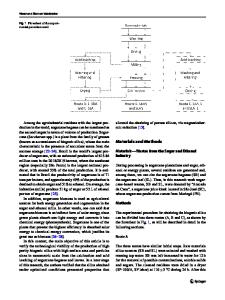Separation of emulsified oil from wastewater using polystyrene and surfactant modified sugarcane bagasse wastes blend
- PDF / 1,593,023 Bytes
- 15 Pages / 595.276 x 790.866 pts Page_size
- 14 Downloads / 311 Views
ORIGINAL PAPER
Separation of emulsified oil from wastewater using polystyrene and surfactant modified sugarcane bagasse wastes blend N. A. Abdelwahab1 · N. Shukry2 · S. F. El‑kalyoubi2 Received: 5 April 2020 / Accepted: 18 October 2020 © Springer-Verlag GmbH Germany, part of Springer Nature 2020
Abstract A recent trend for converting a hydrophilic lignocellulosic material into oleophilic adsorbent could be achieved by using cationic surfactants. In the present work, the surface of sugarcane bagasse was modified by cationic surfactant cetyltrimethylammonium bromide, whereas sugarcane bagasse acquired hydrophobic properties. Further increase in hydrophobicity of sugarcane bagasse could be obtained by blending surfactant modified sugarcane bagasse with polystyrene waste. Sugarcane bagasse, surfactant modified bagasse and polystyrene waste/surfactant modified bagasse were characterized by different physical and chemical techniques. Remarkable changes in the structure of sugarcane bagasse as a result of the different treatment processes could be evidenced by FT-IR, SEM and XRD measurements. Moreover, elemental analysis, specific surface area as well as water absorption capacity results confirmed successful modification of sugarcane bagasse by both cetyltrimethylammonium bromide and polystyrene waste. Also, water absorption capacity experiments indicated that hydrophobic properties of the different samples increased in the order: polystyrene waste/surfactant modified bagasse > surfactant modified bagasse > sugarcane bagasse. The different samples were evaluated for removal of emulsified food oil from aqueous solutions. The effect of various parameters, e.g., blend constituents weight ratio, adsorbent dose, initial oil concentration, pH and contact time upon oil removal efficiency, was investigated. Isothermal studies revealed that oil adsorption fitted Freundlich model and thermodynamics studies showed that oil adsorption is spontaneous, random and exothermic.
* N. A. Abdelwahab [email protected] 1
Polymers and Pigments Department, National Research Centre, 33 El Bohouth st., Dokki, Giza 12622, Egypt
Cellulose and Paper Department, National Research Centre, 33 El Bohouth st., Dokki, Giza 12622, Egypt
2
13
Vol.:(0123456789)
N. A. Abdelwahab et al.
Graphic abstract
Keywords Sugarcane bagasse · Polystyrene waste · Cetyltrimethylammonium bromide · Emulsified oil · Removal
Introduction Effluents of several industries, such as metal and food processing, petroleum refiners, textiles and paints contain oil in the form of oil-in-water emulsion. Such emulsion is formed of a mixture of poorly degradable light and heavy hydrocarbons (Dumore and Mukhopadhyay 2012), water and emulsifier. The emulsifier can be a detergent or food additives. Oil emulsion is toxic and poses harmful effects on aquatic life and human health, even at low oil concentration, it prevents access of sunlight and oxygen to aquatic organisms by forming a stable layer on the water surface (Zhou et al. 2008).
13
Several chemical, physical a
Data Loading...











